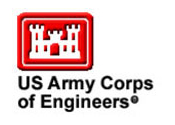
U.S. Army Corps of Engineers releases Interim Report III & IIIA
ACRCC releases new studies related to Asian carp fight
FOR IMMEDIATE RELEASE
June 3, 2010
Lynne Whelan 312-846-5330
Read the USACE’s Interim Report III & IIIA
Chicago – The Asian Carp Regional Coordinating Committee (ACRCC) announced today that the U.S. Army Corps of Engineers has conducted two studies focused on enhancing the efficacy of the electric barrier system and reducing the risk of Asian carp reaching the Great Lakes.
Preventing Asian carp migration into Lake Michigan is a multi-agency collaborative effort, involving numerous federal, state, and local agencies. The Asian Carp Regional Coordinating Committee is developing a phased (short, near, and long-term) series of plans to address this issue.
The Electric Barrier System was designed to reduce the risk of inter-basin transfer of fish between the Mississippi River and Great Lakes drainage basins via the Chicago Sanitary and Ship Canal. It consists of three electrical barriers, Barrier I, IIA and IIB. Barriers I and IIA are constructed and in operation. Construction of Barrier IIB is underway and will be completed in 2010.
The U.S. Army Corps of Engineers (USACE) was directed in the Water Resources Development Act 2007 to conduct a study of a range of options or technologies for reducing impacts of hazards that may reduce the efficacy of the Electrical Dispersal Barriers located on the Chicago Sanitary and Ship Canal (CSSC). To expedite the evaluation, USACE divided the Efficacy study into several phases. Today USACE and its partner agencies in the ACRCC released the interim III and IIIA reports for public review.
"Interim IIIA, Fish Deterrent Barriers, Illinois and Chicago Area Waterways Risk Reduction Study and Integrated Environmental Assessment" considered how technologies such as bubbles, lights and sounds could be used to deter Asian carp movement. In the course of this evaluation, USACE determined that, while these technologies do show promise, further testing and calibration of this tool against Asian carp is needed. In addition, there is significant expense associated with the fabrication and installation of this technology. USACE recommends installing one acoustic bubble curtain with strobe lights (ABS fish deterrent) near the Brandon Road Lock and Dam as a demonstration project.
"The demonstration deterrent system would allow USACE to not only evaluate the effectiveness of the tool, but would also help us calibrate the ABS fish deterrent to the most effective settings for Asian carp. It would be located in an area where Asian carp are known to exist and where it has the potential to help the fish management agencies reduce the population of Asian carp," said Colonel Vincent Quarles, Commander of the U.S. Army Corps of Engineers in Chicago.
The second report, "Interim III, Modified Structures Operations, Chicago Area Waterways Risk Reduction Study and Integrated Environmental Assessment," evaluated the potential for risk reduction that might be achieved through changes in the operation of the Chicago Area Waterway structures, such as locks, sluice gates, and pumping stations.
The report includes a Risk Assessment, prepared by USFWS based on input from a panel of experts. The risk assessment considered possible lock operation alternatives as well as biological, ecological and risk management factors.
The Expert Risk Analysis Panel concluded there is no individual or combination of lock operation scenarios will lower risk of Asian carp establishing self-sustaining populations in Lake Michigan to an acceptable level.
The report's primary recommendation is to place screens on the outer two sluice gates at the T.J. O'Brien Lock and Dam. The Metropolitan Water Reclamation District of Greater Chicago already placed similar screens on sluice gates at the Chicago River Controlling Works.
After conducting a thorough analysis of modifications to lock operations, the report recommends intermittent lock operation on a case-by-case basis in support of fish management efforts such as spot piscicide application, or intensive commercial fishing efforts by the U.S. Fish and Wildlife (USFWS) and Illinois Department of Natural Resources (IDNR).
"USACE considered many factors in this assessment of potential use of structures, including impacts to the environment, local and regional economy, health and safety," said Quarles. "Our analysis incorporated information gathered from US FWS and other Asian carp experts. In the end the analysis showed that using measures such as temporary lock closures will do very little to reduce the risk of Asian carp migration."
"These studies are further examples of the hard work and thought put into the Asian carp issue on a daily basis by ACRCC members," said IDNR Assistant Director and ACRCC Co-Chair John Rogner. "The work of the ACRCC is not done and the Illinois DNR will continue to work with all of our partners to keep populations of Asian carp from establishing in the great lakes."
Copies of both reports are available on the Chicago District website at www.lrc.usace.army.mil. Interim Report IIIA is a final report. The public comment period for the draft Interim III report will end on June 15, 2010. Comments may be sent to the U.S. Army Corps of Engineers at ChicagoDistrict.PAO@usace.army.mil. For additional information, contact the Chicago District at (312) 846-5330.
